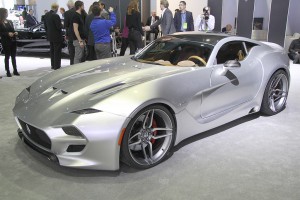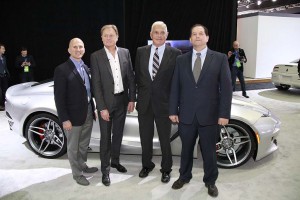
The VLF Force 1 went from little more than a sketch to driveable prototype in just 10 weeks. Photo Len Katz
(This story has been updated with new information about the VLF Force 1.)
Two automotive industry veterans are planning to make a return to the market, Danish designer Henrik Fisker and former General Motors Vice Chairman Bob Lutz serving as two of the key partners in the new VLF Automotive.
They’ll be joined by industrialist Gilbert Villarreal in the venture, which will present its limited-edition supercar, the Force 1, at the North American International Auto Show in Detroit this week.
“I’m honored to become a partner in this automotive ‘Dream Team’,” said Fisker, who served as the chief designer at Aston on projects like the DB9 before setting up his own venture, Fisker Automotive. That plug-in hybrid maker went bankrupt in 2013.
Since the eponymous battery-car company crashed, Fisker has worked on several new projects, including the Rocket, a reskinned, higher-performance take on the Ford Mustang. He has also been looking to develop something more exotic, teasing the debut of the Force 1 last month.
Other than offering a teaser shot, little was revealed about the Force 1 before its Detroit Auto Show debut except to note that it will use what Fisker claims to be the world’s most powerful naturally aspirated engine.
(Henrik Fisker files $100 million lawsuit against Aston Martin. For more, Click Here.)
TheDetroitBureau.com has since learned the supercar will be motivated by a racing-tuned version of the Dodge Viper’s 8.4-liter V-10 — about 100 hp more than the standard-edition snake.
Indeed, much of what’s under the all-carbon fiber body that Fisker has designed is a current-model Viper, though Lutz told TheDetroitBureau.com that the suspension is modified to become “semi-active.” That translates into an electronic system for the lower control arm that stiffens up on the loaded wheel as a Force 1 does its maneuvers. The tires, meanwhile, are wider than the stock Viper offers.
The automotive legend also noted that the entire project came together in “just 10 weeks, from sketch to fully functional car.”
The limited-production sports car will carry the diamond-shaped VLF badge. And it will be produced along with the Destino. That model was originally shown at the NAIAS in 2013 and was developed by what was then known as VL Automotive, a partnership of Lutz and Villarreal.
Ironically, at one point VL teamed up with China’s Wanxiang Group in an attempt to buy up the assets of the bankrupt Fisker Automotive.
“It’s a circle,” said the 83-year-old Lutz. “When Gilbert and I formed VL Automotive in 2012, we wanted to take Henrik’s beautifully proportioned design, replace the hybrid gas-electric power train with a Chevrolet Corvette ZR1 drivetrain, and create a bespoke four-door luxury car with outstanding performance.”
(Click Here for more on the Fisker Force 1.)
Now, Fisker will help this “dream team” tweak the design of the Destino, while also launching the Force 1 later this year. That is, however, if Fisker and VLF don’t wind up in a legal battle with the designer’s former employer. Last week, Fisker announced a lawsuit against Aston Martin for allegedly interfering with his plans for the Force 1. The two sides have faced off several times in recent years.
Barring such a setback, VLF wants to have the Force 1 in production this year, and claims it now has seven dealers around the country that will sell and service its products. While specific details apparently won’t be released until an NAIAS news conference, VLF says the sports car will make 638 horsepower and 604 pound-feet of torque, launch fro 0 to 60 in 3.9 seconds, and top out at 200 mph.
As for the Destino, Fisker is now working on a design update. Powered by a Corvette LS9 V-8, the current version of the American-made GT car goes for $229,000.
(To see more about Henrik Fisker’s development of the Force 1, Click Here.)
The original VL partnership paired two ex-Marine aviators. Villarreal has worked in a number of different industries, including aerospace, marine and automotive, since hanging up his flying suit. As for Lutz, he retired from GM in 2010, but in the previous 47 years of his career worked for an array of automakers including BMW, Ford and Chrysler.




They need a sales and/or marketing person to come up with better vehicle names.